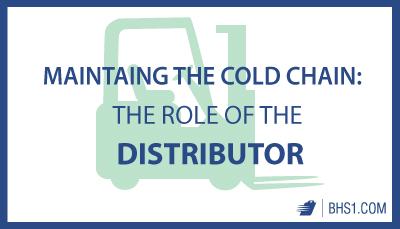We use cookies to make your experience better. To comply with the new e-Privacy directive, we need to ask for your consent to set the cookies. Learn more.
Maintaining the Cold Chain: The Role of the Distributor
Food safety depends on maintaining the cold chain at every step, from producer to processor to foodservice operation to, eventually, the diner's plate. In the United States, a handful of federal agencies regulate all the industries involved in taking food from farm to fork. These include the U.S. Department of Agriculture (USDA), the Food and Drug Administration (FDA), and even the Centers for Disease Control and Prevention (CDC) — but these agencies are often stretched thin, and they can't oversee every operation.
In actual practice, food distribution companies can be great or not-so-great, and the key to maintaining safe, high-quality food products is to know how to tell the difference. Here are a few things to look for when choosing a distributor for food products on either side of the food-handling journey, whether you're a producer or a foodservice provider:
-
Maintaining the cold chain is perhaps most challenging during loading and unloading, which must occur at several points during a products life-cycle. Most outbound deliveries at food distribution centers involve less-than-truckload shipments. Each trailer can contain hundreds of SKUs with different temperature requirements, from frozen to refrigerated to ambient dry transport. Bulkheads and cooling jets can compartmentalize the trailer, but be wary of distributors who ship mixed loads (frozen, refrigerated, and/or dry) in a trailer without multiple temperature zones.
-
Distributors must carefully organize trailers. Some foods will contaminate others, and must remain strictly separated. Products must be stacked with the heaviest items on the bottom. And the quicker an operation can complete these tasks, the less chance they have to thaw at the dock. A best-in-class distribution center will have adequate material handling equipment, including cold-ready forklifts, to move pallets quickly when the cold chain is at stake.
-
Cleanliness is extremely important for food distribution, and not only in the trailers themselves. All material handling equipment should be clean and emissions-free. Choose distribution centers that run electric forklifts, and be sure to look into the forklift battery room. If the battery room is clean and stocked with adequate Battery Wash Equipment, that's a terrific sign.
-
Refrigerated docks are a must for any operation that offers cross-docking, or "merge-in-transit" services for refrigerated or frozen goods. This practice, developed for dry goods, involves redistribution products straight from one truck to another at the loading dock, rather than going into storage. On an unrefrigerated dock, this practice creates too many opportunities for temperature fluctuations between trucks.

Distribution is the unsung hero of the international food system. As a society, we tend to pay a lot of attention to producers, such as farmers, and to foodservice operations, such as restaurants and grocery stores. Without distributors, though, these two points would remain unlinked; without distribution, we'd all be eating only what we could catch or grow. And the key to excellent food distribution is, of course — say it with us, now — maintaining the cold chain.
References:
Hernandez, Jorge. "Foodservice Distribution: Maintaining the Cold Chain." FoodSafetyMagazine. Food Safety Magazine, Aug./Sept. 2009. Web. 18 Aug. 2018.
